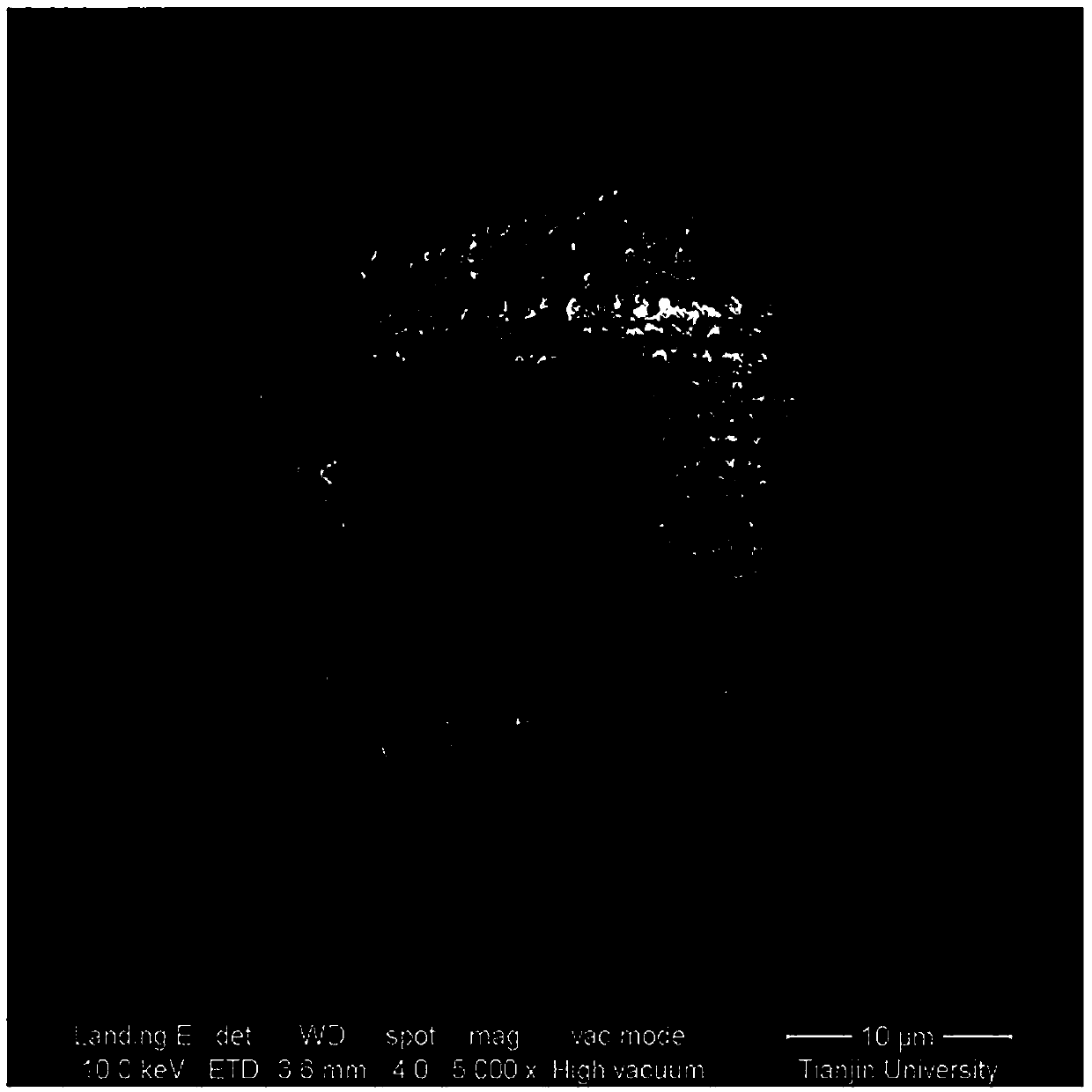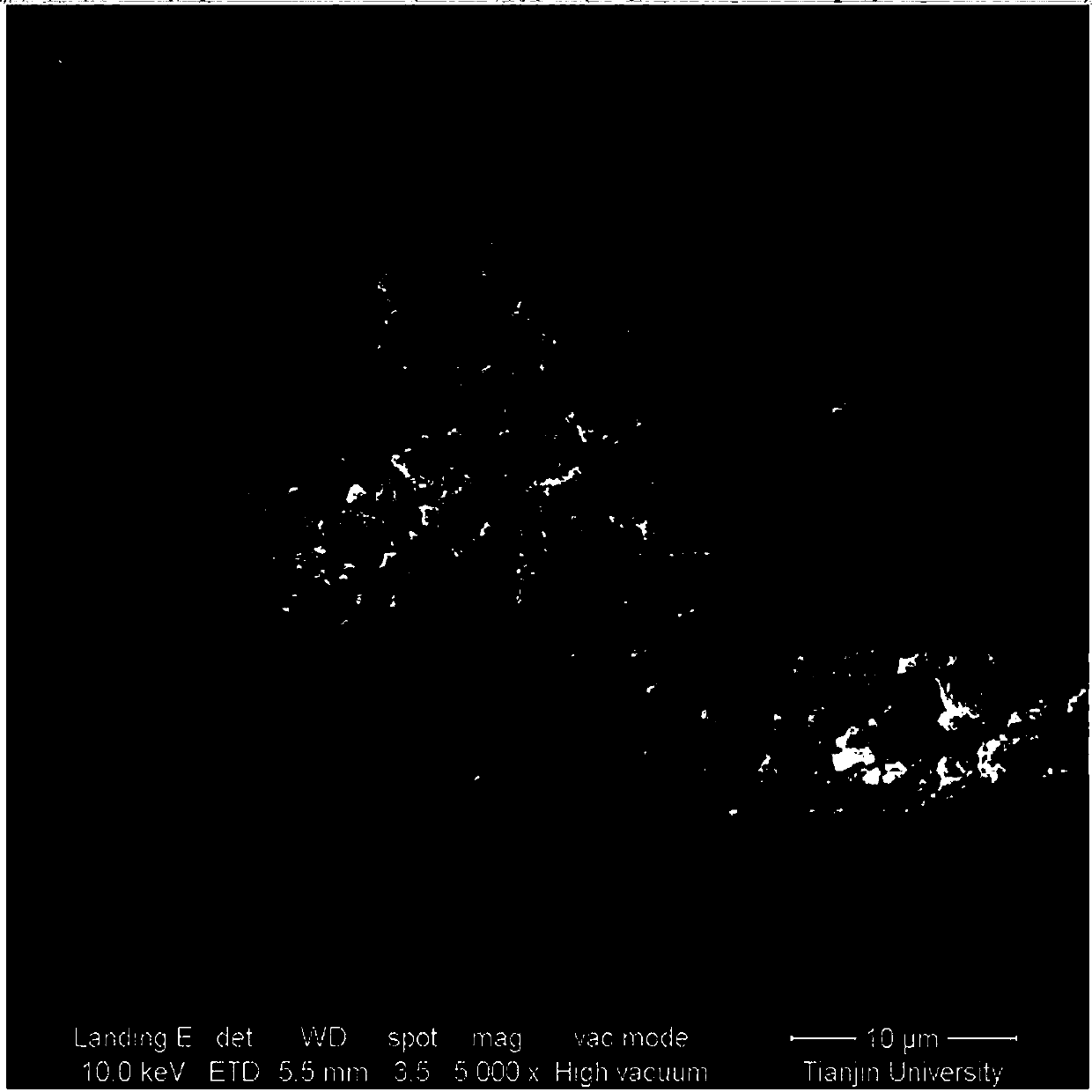Preparation method of porous polyimide microspheres
A technology of polyimide microspheres and polyamic acid, which is applied in the field of preparation of porous polyimide microspheres, can solve problems such as low solid content, poor reproducibility of preparation methods, and difficult control of micropore morphology and distribution. Achieve the effect of improving production efficiency and simplifying steps
- Summary
- Abstract
- Description
- Claims
- Application Information
AI Technical Summary
Problems solved by technology
Method used
Image
Examples
Embodiment 1
[0036] A preparation method for preparing porous polyimide microspheres, the specific preparation method is as follows:
[0037] Step one, prepare the continuous phase. Dissolve 10.0g of surfactant Span85 in 50ml of liquid paraffin to become the continuous phase;
[0038] Step 2, preparing the dispersed phase. Weigh 1.0g of 4,4'-diaminodiphenyl ether and dissolve it in N,N-dimethylformamide to form a dispersed phase;
[0039] Step 3, forming a non-aqueous inverse emulsion. According to the volume ratio: 1:5 (volume ratio of N,N-dimethylformamide to liquid paraffin), mix the continuous phase prepared in step 1 and the dispersed phase prepared in step 2, and emulsify with ultrasonic stirring , the emulsification time is 60 minutes, adjust the temperature of the system to 20°C, after forming a stable non-aqueous inverse emulsion, add ether at a volume ratio of 1:1 (volume ratio of liquid paraffin to ether);
[0040] Step 4, preparing polyamic acid emulsion and its chemical imid...
Embodiment 2
[0043] This example is basically the same as Example 1, except that 6.0g of surfactant (the mass ratio of Span85 and monoaminopolyetheramine is 2:1) is dissolved in 50ml of liquid paraffin to become the continuous phase; 1.0g of 4,4'-diaminodiphenyl ether is dissolved in N,N-dimethylformamide to become a dispersed phase; the volume ratio of 1:10 (N,N-dimethylacetamide and liquid paraffin volume ratio), mix the continuous phase prepared in step 2 with the dispersed phase prepared in step 1, and emulsify with ultrasonic stirring. The emulsification time is 60 minutes, and the temperature of the system is adjusted to 15°C until a stable non-aqueous reverse phase is formed. After the emulsion, methanol was added in a volume ratio of 10:1 (volume ratio of liquid paraffin to methanol); under nitrogen protection and constant stirring, 1.14 g of solid pyromellitic anhydride was added to the non-aqueous inverse emulsion, After 6 hours of reaction, 2ml of pyridine / acetic anhydride (mola...
Embodiment 3
[0045] This example is basically the same as Example 1, except that 5.0g of surfactant (the mass ratio of Span60 and monoaminopolyetheramine is 1:1) is dissolved in 50ml of liquid paraffin to become the continuous phase; 1.0g of 4,4'-diaminodiphenyl ether is dissolved in N,N-dimethylformamide to become a dispersed phase; the volume ratio of 1:10 (N,N-dimethylacetamide and liquid paraffin volume ratio), mix the continuous phase prepared in step 2 with the dispersed phase prepared in step 1, and emulsify with ultrasonic stirring. The emulsification time is 60 minutes, and the temperature of the system is adjusted to 15°C until a stable non-aqueous reverse phase is formed. After the emulsion, tetrahydrofuran was added at a volume ratio of 2:1 (volume ratio of liquid paraffin to tetrahydrofuran); under nitrogen protection and constant stirring, 1.14 g of solid pyromellitic anhydride was added to the non-aqueous inverse emulsion, After 6 hours of reaction, 3ml of pyridine / acetic an...
PUM
| Property | Measurement | Unit |
|---|---|---|
| particle size | aaaaa | aaaaa |
| specific surface area | aaaaa | aaaaa |
| pore size | aaaaa | aaaaa |
Abstract
Description
Claims
Application Information
 Login to View More
Login to View More - R&D
- Intellectual Property
- Life Sciences
- Materials
- Tech Scout
- Unparalleled Data Quality
- Higher Quality Content
- 60% Fewer Hallucinations
Browse by: Latest US Patents, China's latest patents, Technical Efficacy Thesaurus, Application Domain, Technology Topic, Popular Technical Reports.
© 2025 PatSnap. All rights reserved.Legal|Privacy policy|Modern Slavery Act Transparency Statement|Sitemap|About US| Contact US: help@patsnap.com



